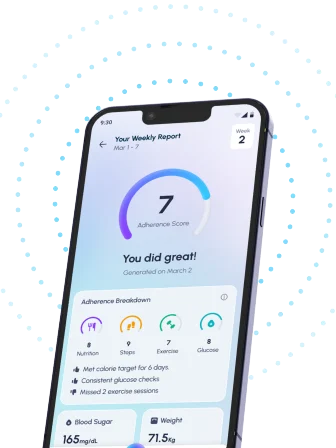Table of Contents
- Understanding Diabetic Neuropathy: Causes and Symptoms
- Numbness in Diabetes: Effective Management Strategies
- Diabetic Neuropathy: A Guide to Prevention and Treatment
- Is Numbness a Sign of Diabetes? Recognizing Early Symptoms
- Managing Tingling and Numbness Related to Diabetes
- Frequently Asked Questions
- References
Living with diabetes can present many challenges, and one often overlooked yet significant issue is nerve damage, leading to numbness. This can significantly impact your quality of life, making everyday tasks difficult. Understanding Diabetes-Related Numbness: Causes, Symptoms, and Management is crucial for effective self-care and preventing further complications. In this blog post, we’ll explore the underlying causes of this type of numbness, help you identify the key symptoms, and provide practical strategies for managing and mitigating its effects. Let’s dive in and empower you to take control of your health.
Understanding Diabetic Neuropathy: Causes and Symptoms
Causes of Diabetic Neuropathy in Indian and Tropical Countries
Diabetic neuropathy, a nerve damage complication of diabetes, significantly impacts the lives of 30-50% of patients. In India and other tropical regions, several factors may exacerbate this condition. High rates of undiagnosed and poorly managed diabetes, coupled with prevalent nutritional deficiencies and infections, contribute to the increased prevalence and severity of diabetic neuropathy. Heat and humidity, common in tropical climates, can also worsen nerve pain and discomfort. Poor glycemic control is a primary driver, leading to prolonged exposure of nerves to high blood sugar levels, damaging their structure and function. Lifestyle factors, such as a lack of physical activity and unhealthy diets, further increase the risk.
Symptoms of Diabetic Neuropathy
Symptoms can vary widely depending on the type of neuropathy. Peripheral neuropathy, the most common type, often presents as numbness, tingling, or burning sensations in the feet and hands. This can progress to pain, weakness, and reduced mobility, making everyday tasks challenging. In some cases, individuals experience severe pain, impacting sleep and quality of life. Autonomic neuropathy affects the nerves controlling internal organs, potentially leading to digestive issues, bladder dysfunction, and heart problems. Early detection and management are crucial to minimize complications and improve patient outcomes. Recognizing these symptoms early is vital, especially in regions with limited access to specialized healthcare. It’s important to note that while this article focuses on diabetic neuropathy, neuropathy can also occur without diabetes, highlighting the importance of comprehensive diagnosis. For those exploring alternative treatments, learn more about the potential role of THC in managing diabetic neuropathy.
Numbness in Diabetes: Effective Management Strategies
Numbness, a common diabetic neuropathy symptom, significantly increases the risk of serious complications. Nearly 15% of individuals with diabetes experience foot ulcers in their lifetime, often leading to amputations. Early detection and proactive management are crucial, especially in hot and humid climates prevalent in Indian and tropical countries, where infections can spread rapidly.
Identifying and Addressing Numbness
Recognizing the signs of numbness, tingling, or burning sensations in your feet and hands is the first step. This often starts subtly and can progress if left untreated. Regular self-examination of your feet, paying close attention to any areas of reduced sensation, is essential. In tropical climates, increased sweating can mask minor injuries, making regular checks even more important. Diabetic foot exams by healthcare professionals are also vital for early detection of any problems.
Practical Management Tips
Maintaining good blood glucose control is paramount in preventing and managing diabetic neuropathy. This is achieved through a balanced diet, regular exercise, and adherence to prescribed medications. Proper foot care is also critical; this includes daily washing and moisturizing of your feet, avoiding tight-fitting shoes, and promptly treating any cuts or blisters. In hot and humid climates, wearing breathable footwear and cotton socks is crucial to prevent excessive sweating and reduce infection risk. For more comprehensive strategies, see our guide on 10 Proven Tips for Effective Diabetes Management.
Seeking Expert Advice in India and Tropical Regions
If you experience any numbness or tingling, consult a doctor immediately. Early intervention significantly reduces the risk of developing foot ulcers and amputations. Many hospitals and clinics in India and tropical countries offer specialized diabetic foot care services. Don’t delay; proactive management can save your feet and improve your quality of life. The challenges of managing diabetes can increase with age, so it’s important to be proactive. Learn more in our article on Managing Diabetes as You Age: Challenges and Solutions.
Diabetic Neuropathy: A Guide to Prevention and Treatment
Understanding the Risks in Indian and Tropical Climates
Diabetes significantly increases the risk of nerve damage, a condition known as diabetic neuropathy. This is particularly crucial in hot and humid climates prevalent in many Indian and tropical countries, where pre-existing conditions can exacerbate the issue. The discomfort and functional limitations caused by neuropathy can be substantial, impacting daily life significantly. Remember, nearly 30% of people with diabetes develop diabetic nephropathy (kidney disease), highlighting the importance of proactive management.
Symptoms and Early Detection
Early signs of diabetic neuropathy often include numbness, tingling, or burning sensations in the feet and hands. These can progress to pain, weakness, and even loss of reflexes. Early detection is vital for preventing irreversible damage. Regular check-ups with your doctor, including blood sugar monitoring and nerve function tests, are crucial. Paying close attention to even minor changes in sensation is paramount, especially in individuals with a family history of diabetes or other risk factors.
Prevention and Management Strategies
Maintaining optimal blood glucose control is the cornerstone of preventing and managing diabetic neuropathy. This involves adhering strictly to your prescribed medication regimen, maintaining a healthy diet, and engaging in regular physical activity. Incorporating lifestyle changes such as quitting smoking and managing stress levels can also significantly reduce the risk. Additionally, wearing comfortable, supportive footwear and protecting your feet from injury are key to preventing complications. A well-planned Diet Chart for Diabetic Patients to Control Diabetes can be incredibly helpful in this regard.
Seeking Expert Care in Your Region
Consult with a healthcare professional immediately if you experience any symptoms of diabetic neuropathy. They can provide personalized advice, tailored to your specific needs and the challenges presented by the climate in your region. Don’t delay seeking help – proactive management can significantly improve your quality of life and prevent long-term complications. Early intervention is key to avoiding further damage and improving your overall well-being. If you’re planning any travel, be sure to check out our guide on Traveling with Diabetes: Essential Tips for a Safe & Healthy Journey to ensure your blood sugar remains stable while you’re away from home.
Is Numbness a Sign of Diabetes? Recognizing Early Symptoms
Understanding the Link Between Diabetes and Numbness
Numbness, or paresthesia, in the hands and feet is a common symptom of diabetes, often stemming from diabetic neuropathy. This nerve damage arises from consistently high blood sugar levels damaging the nerves over time. The alarming fact is that 50% of diabetes cases worldwide remain undiagnosed, highlighting the critical need for early detection. In India and other tropical countries, where diabetes prevalence is high, recognizing early symptoms like numbness is crucial for timely intervention and preventing serious complications.
Types and Symptoms of Diabetic Neuropathy
Diabetic neuropathy isn’t always straightforward. It can manifest as tingling, burning, shooting pains, or a complete loss of feeling, primarily in the extremities. The severity varies, and some individuals experience mild discomfort, while others endure debilitating pain. In hot and humid climates prevalent in many tropical regions, these symptoms might be easily dismissed or attributed to other causes, delaying diagnosis. Early recognition is key to effective management and preventing further nerve damage. For more information on early signs, you might find 10 Early Signs and Symptoms of Diabetes? – Tap Health helpful.
Seeking Help and Managing the Condition
If you experience persistent numbness, tingling, or pain in your hands or feet, especially if accompanied by other diabetes symptoms like increased thirst, frequent urination, or unexplained weight loss, it’s vital to consult a doctor immediately. Early diagnosis allows for proactive management of blood sugar levels, which is the most effective way to prevent or slow the progression of diabetic neuropathy. In India and other tropical countries, access to healthcare varies; therefore, seeking prompt medical attention is paramount to avoiding long-term health issues. Don’t ignore these warning signs; your health depends on it. It’s also worth noting that other symptoms, such as cramps, can be associated with diabetes. To learn more, read Can Diabetes Cause Cramps? Understanding the Connection.
Managing Tingling and Numbness Related to Diabetes
Diabetes, a growing concern globally, especially in India and other tropical countries, significantly impacts a large population. Data reveals that 61% of people with diabetes are aged between 20-64 years, highlighting the condition’s prevalence among working-age adults in these regions. One common and often distressing symptom is peripheral neuropathy, causing tingling, numbness, and pain, particularly in the hands and feet.
Understanding Diabetic Neuropathy
Diabetic neuropathy arises from high blood sugar damaging nerves over time. This damage can lead to a range of sensations, from mild tingling and prickling to severe burning pain and complete numbness. The severity varies depending on the individual and the duration of their diabetes. In tropical climates, existing heat and humidity can exacerbate the discomfort associated with neuropathy. Early detection and management are crucial to prevent irreversible nerve damage.
Practical Tips for Managing Numbness
Managing blood sugar levels is paramount. Strict adherence to your doctor’s prescribed treatment plan, including medication and dietary changes, is vital. Regular blood glucose monitoring helps maintain control and minimize nerve damage. Foot care is also extremely important. Daily inspection of your feet for cuts, blisters, or infections is essential, as decreased sensation makes you less aware of injuries. Wear comfortable, well-fitting shoes and avoid walking barefoot. Lifestyle changes, such as regular exercise and a balanced diet low in saturated fats and sugars, can significantly improve nerve function and overall health. Finally, consult your doctor or a specialist for appropriate pain management strategies and potential therapies. Early intervention significantly improves the quality of life for individuals experiencing diabetes-related numbness in India and other tropical countries. Note that other symptoms, such as loss of taste and smell, can also be associated with diabetes, highlighting the importance of comprehensive management and regular check-ups. Maintaining a strong immune system is also crucial, so consider learning more about boosting immunity while managing diabetes.
Frequently Asked Questions on Understanding Diabetes-Related Numbness
Q1. What is diabetic neuropathy and how common is it?
Diabetic neuropathy is nerve damage caused by diabetes. It’s a common complication, affecting 30-50% of people with diabetes.
Q2. What are the common symptoms of diabetic neuropathy?
Common symptoms include numbness, tingling, burning sensations, and pain, usually in the extremities (hands and feet). These can lead to reduced mobility and affect your quality of life.
Q3. How can I manage or prevent diabetic neuropathy?
The most effective management involves strictly controlling your blood sugar through diet, exercise, and medication. Regular foot care is also crucial to prevent infections and injuries. Early detection is key.
Q4. What are the potential risks if diabetic neuropathy is left untreated?
Untreated diabetic neuropathy can lead to serious complications like foot ulcers and amputations. It’s especially important to seek prompt medical attention, particularly if you live in an area with limited healthcare access.
Q5. Does living in a tropical climate increase my risk of diabetic neuropathy?
Yes, factors like heat, humidity, infections, and nutritional deficiencies common in tropical climates can worsen diabetic neuropathy. Careful management of diabetes is even more critical in these environments.
References
- A Practical Guide to Integrated Type 2 Diabetes Care: https://www.hse.ie/eng/services/list/2/primarycare/east-coast-diabetes-service/management-of-type-2-diabetes/diabetes-and-pregnancy/icgp-guide-to-integrated-type-2.pdf
- What is Diabetes: https://www.medschool.lsuhsc.edu/genetics/docs/DIABETES.pdf




